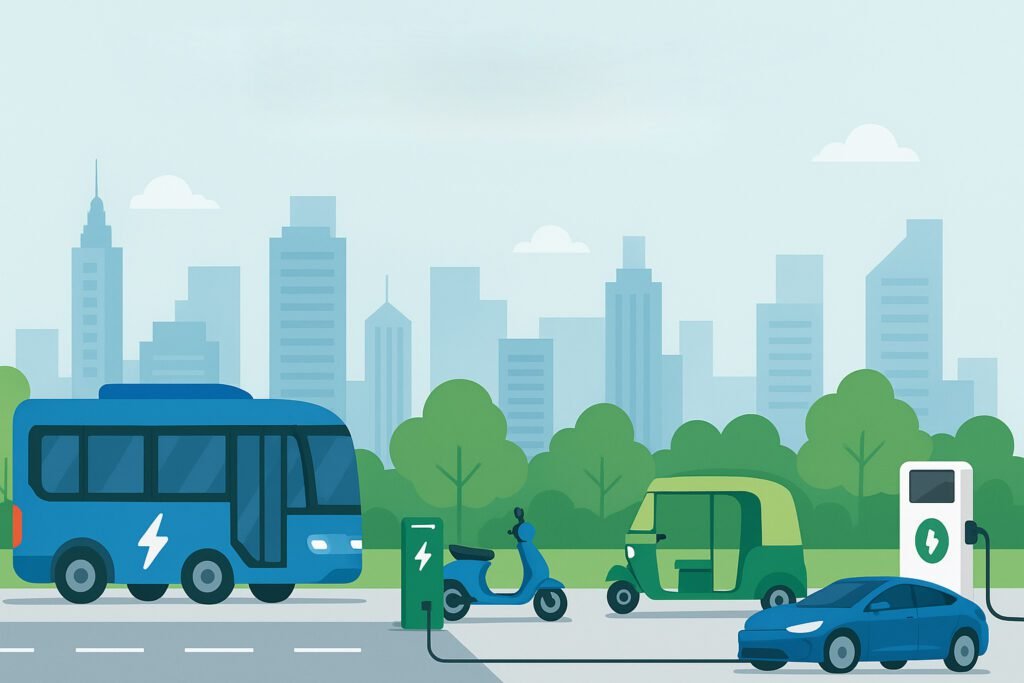The global transport landscape is undergoing a monumental transformation, and at the center of this change lies the rise of electric vehicles (EVs). From two-wheelers to buses, cities across India and the world are witnessing a rapid shift toward electric mobility. This movement is not merely about new technology—it represents a complete rethinking of how people and goods move in urban environments.
The EV Revolution in Urban Mobility
Electric Vehicles have emerged as a game-changer for urban transport. With their silent operation, zero tailpipe emissions, and lower operating costs, EVs are redefining the concept of sustainable commuting. For densely populated cities struggling with pollution and congestion, EV adoption provides a much-needed solution.
The Indian EV market has grown exponentially in recent years, driven by government initiatives such as FAME II (Faster Adoption and Manufacturing of Electric Vehicles), tax incentives, and state-level subsidies. From e-rickshaws in Delhi to e-buses in Mumbai and electric two-wheelers in Bengaluru, EVs are rapidly becoming part of the daily transport fabric.
Cleaner, Quieter, and Greener Cities
One of the most visible benefits of EVs is the reduction in urban air pollution. Conventional vehicles are responsible for a significant portion of particulate matter and greenhouse gas emissions in cities. By replacing internal combustion engine (ICE) vehicles with EVs, cities can dramatically cut emissions of CO₂, NOx, and PM 2.5, improving overall air quality and public health.
EVs are also quieter, reducing noise pollution—a major but often overlooked issue in metropolitan areas. The hum of electric motors is far less intrusive than the roar of petrol and diesel engines, creating calmer, more livable streets.
Together, these improvements make cities cleaner, quieter, and more sustainable, enhancing the overall quality of urban life.
Transforming Public and Shared Transport
Public transport is at the forefront of this transformation. Municipal corporations across India have begun electrifying bus fleets, replacing diesel buses with cleaner and more efficient electric alternatives. These buses not only lower emissions but also reduce operating and maintenance costs, allowing for long-term financial savings for city administrations.
Shared mobility is another area witnessing a surge in electrification. Electric taxis, auto-rickshaws, and ride-sharing fleets are becoming increasingly common. Companies like Ola Electric and BluSmart are investing heavily in electric fleets and charging infrastructure. This shift aligns perfectly with the rise of Mobility-as-a-Service (MaaS) platforms, which integrate electric shared vehicles into digital urban mobility ecosystems.
The Charging Infrastructure Challenge
A key factor enabling the EV revolution is the availability of charging infrastructure. Until recently, a lack of public charging points was one of the biggest barriers to adoption. Today, both government and private players are making significant progress in building fast-charging networks across highways, parking areas, malls, and workplaces.
Innovations such as swapping stations for e-rickshaws and two-wheelers, smart grid integration, and solar-powered charging units are emerging as scalable solutions. Urban planners are now incorporating EV charging points into city infrastructure plans, ensuring accessibility and convenience for all types of EV users.
Economic and Environmental Impact
Beyond environmental benefits, EVs bring substantial economic advantages. Operating costs for EVs are typically 70–80% lower than those for conventional vehicles due to reduced fuel and maintenance expenses. For delivery fleets, ride-sharing operators, and logistics companies, these savings translate into higher profitability and competitive advantage.
Moreover, as the demand for EVs grows, so does the local manufacturing ecosystem. India’s push for domestic production of batteries, motors, and power electronics under the Make in India and PLI schemes is creating new job opportunities and reducing dependence on imports.
Environmentally, the shift to EVs also supports India’s commitment to net-zero carbon emissions by 2070, contributing to global sustainability goals.
Integration with Renewable Energy
A major advantage of EVs is their potential synergy with renewable energy systems. When charged using solar or wind power, EVs become part of a clean energy loop, further reducing their carbon footprint. In fact, the concept of Vehicle-to-Grid (V2G) technology allows EVs to feed power back into the grid during peak demand, making them active participants in energy management.
This integration marks a shift from EVs being merely transport tools to becoming mobile energy assets—flexible, smart, and sustainable.
The Road Ahead
The future of city transport is undoubtedly electric. However, realizing this vision requires continued efforts in policy support, infrastructure expansion, and public awareness. Education about EV benefits, financing options, and battery warranties will help overcome hesitation among potential buyers.
With advances in battery technology, including lithium-ion and solid-state solutions, we can expect better range, faster charging, and longer lifespans. Cities are likely to see dedicated EV zones, smart traffic systems, and integrated multimodal hubs that bring together buses, metros, and shared EV fleets.

